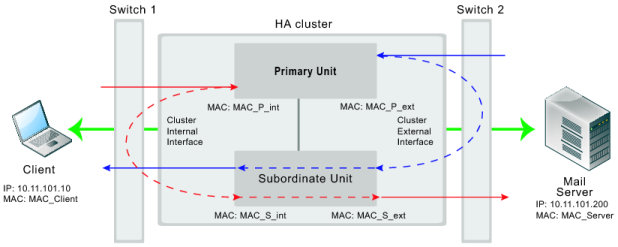Transparent mode active-active cluster packet flow
This section describes an example of how packets are load balanced and how failover occurs in an active-active HA cluster running in Transparent mode. The cluster is installed on an internal network in front of a mail server and the client connects to the mail server through the Transparent mode cluster.
In Transparent mode, six MAC addresses are involved in active-active communication between a client and a server when the primary unit load balances packets to the subordinate unit:
• Client MAC address (MAC_Client),
• Server MAC address (MAC_Server),
• Primary unit original internal MAC address (MAC_P_int),
• Primary unit original external MAC address (MAC_P_ext),
• Subordinate unit internal MAC address (MAC_S_int),
• Subordinate unit external MAC address (MAC_S_ext).
The HA virtual MAC addresses are not directly involved in communicate between the client and the server. The client computer sends packets to the mail server and the mail server sends responses. In both cases the packets are intercepted and load balanced among cluster members.
The cluster’s presence on the network and its load balancing are transparent to the client and server computers. The primary unit sends gratuitous ARP packets to Switch 1 that associate all MAC addresses on the network segment connected to the cluster external interface with the external virtual MAC address. The primary unit also sends gratuitous ARP packets to Switch 2 that associate all MAC addresses on the network segment connected to the cluster internal interface with the internal virtual MAC address. In both cases, this results in the switches sending packets to the primary unit interfaces.


